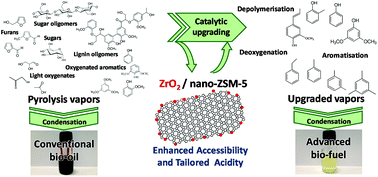当前位置:
X-MOL 学术
›
Green Chem.
›
论文详情
Our official English website, www.x-mol.net, welcomes your
feedback! (Note: you will need to create a separate account there.)
Engineering the acidity and accessibility of the zeolite ZSM-5 for efficient bio-oil upgrading in catalytic pyrolysis of lignocellulose
Green Chemistry ( IF 9.3 ) Pub Date : 2018-06-22 , DOI: 10.1039/c8gc01722k Héctor Hernando 1, 2, 3, 4 , Ana M. Hernández-Giménez 5, 6, 7, 8, 9 , Cristina Ochoa-Hernández 10, 11, 12, 13 , Pieter C. A. Bruijnincx 5, 6, 7, 8, 9 , Klaartje Houben 7, 14, 15, 16, 17 , Marc Baldus 7, 14, 15, 16, 17 , Patricia Pizarro 1, 2, 3, 4, 18 , Juan M. Coronado 1, 2, 3, 4 , Javier Fermoso 1, 2, 3, 4 , Jiří Čejka 10, 11, 12, 13 , Bert M. Weckhuysen 5, 6, 7, 8, 9 , David P. Serrano 1, 2, 3, 4, 18
Green Chemistry ( IF 9.3 ) Pub Date : 2018-06-22 , DOI: 10.1039/c8gc01722k Héctor Hernando 1, 2, 3, 4 , Ana M. Hernández-Giménez 5, 6, 7, 8, 9 , Cristina Ochoa-Hernández 10, 11, 12, 13 , Pieter C. A. Bruijnincx 5, 6, 7, 8, 9 , Klaartje Houben 7, 14, 15, 16, 17 , Marc Baldus 7, 14, 15, 16, 17 , Patricia Pizarro 1, 2, 3, 4, 18 , Juan M. Coronado 1, 2, 3, 4 , Javier Fermoso 1, 2, 3, 4 , Jiří Čejka 10, 11, 12, 13 , Bert M. Weckhuysen 5, 6, 7, 8, 9 , David P. Serrano 1, 2, 3, 4, 18
Affiliation

|
The properties of the zeolite ZSM-5 have been optimised for the production and deoxygenation of the bio-oil* (bio-oil on water-free basis) fraction by lignocellulose catalytic pyrolysis. Two ZSM-5 supports possessing high mesopore/external surface area, and therefore enhanced accessibility, have been employed to promote the conversion of the bulky compounds formed in the primary cracking of lignocellulose. These supports are a nanocrystalline material (n-ZSM-5) and a hierarchical sample (h-ZSM-5) of different Si/Al ratios and acid site concentrations. Acidic features of both zeolites have been modified and adjusted by incorporation of ZrO2, which has a significant effect on the concentration and distribution of both Brønsted and Lewis acid sites. These materials have been tested in the catalytic pyrolysis of acid-washed wheat straw (WS-ac) using a two-step (thermal/catalytic) reaction system at different catalyst/biomass ratios. The results obtained have been assessed in terms of oxygen content, energy yield and composition of the produced bio-oil*, taking also into account the selectivity towards the different deoxygenation pathways. The ZrO2/n-ZSM-5 sample showed remarkable performance in the biomass catalytic pyrolysis, as a result of the appropriate combination of accessibility and acidic properties. In particular, modification of the zeolitic support acidity by incorporation of highly dispersed ZrO2 effectively decreased the extent of secondary reactions, such as severe cracking and coke formation, as well as promoted the conversion of the oligomers formed initially by lignocellulose pyrolysis, thus sharply decreasing the proportion of the components not detected by GC-MS in the upgraded bio-oil*.
中文翻译:

设计ZSM-5沸石的酸度和可及性,以有效催化木质纤维素纤维素热解过程中生物油的提质
ZSM-5沸石的性能已经过优化,可用于通过木质纤维素催化热解生产生物油*(无水生物油)馏分并进行脱氧。具有高中孔/外部表面积并因此提高的可及性的两种ZSM-5载体已被用来促进木质纤维素初次裂解中形成的大体积化合物的转化。这些载体是纳米晶体材料(n-ZSM-5)和具有不同Si / Al比和酸位点浓度的分层样品(h-ZSM-5)。两种沸石的酸性特征均已通过掺入ZrO 2进行了修饰和调节,这对Brønsted和Lewis酸位点的浓度和分布都有重要影响。这些材料已经在酸洗过的小麦秸秆(WS-ac)的催化热解中使用两步(热/催化)反应系统在不同的催化剂/生物质比下进行了测试。还根据氧气含量,能量产率和生产的生物油*的组成对获得的结果进行了评估,同时还考虑了对不同脱氧途径的选择性。ZrO 2 / n-ZSM-5样品由于可及性和酸性性质的适当组合,在生物质催化热解中显示出显着的性能。特别是通过掺入高度分散的ZrO 2来改变沸石载体的酸度 有效降低了副反应的程度,例如严重的裂解和焦炭形成,并促进了木质纤维素热解最初形成的低聚物的转化,从而大大降低了在升级版生物燃料中GC-MS无法检测到的组分的比例油*。
更新日期:2018-07-30
中文翻译:

设计ZSM-5沸石的酸度和可及性,以有效催化木质纤维素纤维素热解过程中生物油的提质
ZSM-5沸石的性能已经过优化,可用于通过木质纤维素催化热解生产生物油*(无水生物油)馏分并进行脱氧。具有高中孔/外部表面积并因此提高的可及性的两种ZSM-5载体已被用来促进木质纤维素初次裂解中形成的大体积化合物的转化。这些载体是纳米晶体材料(n-ZSM-5)和具有不同Si / Al比和酸位点浓度的分层样品(h-ZSM-5)。两种沸石的酸性特征均已通过掺入ZrO 2进行了修饰和调节,这对Brønsted和Lewis酸位点的浓度和分布都有重要影响。这些材料已经在酸洗过的小麦秸秆(WS-ac)的催化热解中使用两步(热/催化)反应系统在不同的催化剂/生物质比下进行了测试。还根据氧气含量,能量产率和生产的生物油*的组成对获得的结果进行了评估,同时还考虑了对不同脱氧途径的选择性。ZrO 2 / n-ZSM-5样品由于可及性和酸性性质的适当组合,在生物质催化热解中显示出显着的性能。特别是通过掺入高度分散的ZrO 2来改变沸石载体的酸度 有效降低了副反应的程度,例如严重的裂解和焦炭形成,并促进了木质纤维素热解最初形成的低聚物的转化,从而大大降低了在升级版生物燃料中GC-MS无法检测到的组分的比例油*。










































 京公网安备 11010802027423号
京公网安备 11010802027423号